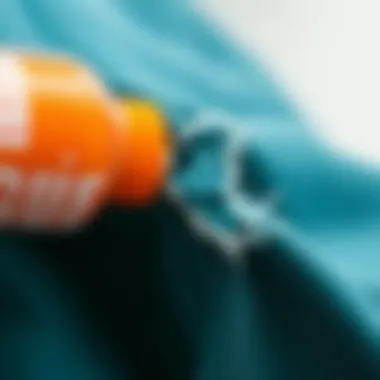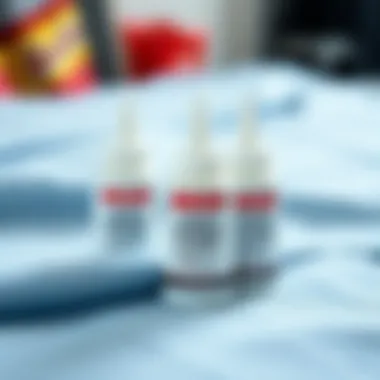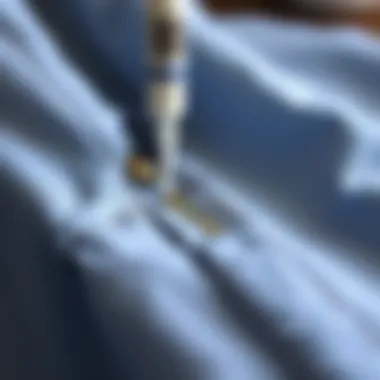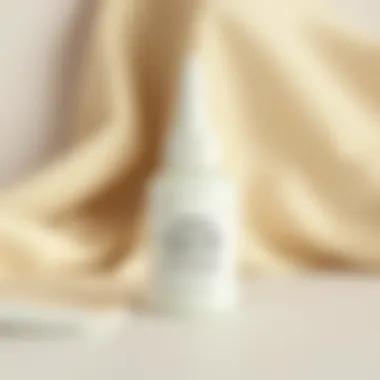Understanding Fabric Mending Glue: Applications and Techniques


Intro
Fabric mending glue has swiftly carved out a niche in the realm of fashion repair and upkeep. It's a topic of growing interest, particularly for those who see garments as more than mere clothing — they recognize them as an expression of identity. Torn seams and unsightly rips have been the downfall of many a beloved attire, yet, armed with fabric mending glue, they can be resurrected with care and creativity. This guide aims to unpack not just the how-to of fabric mending glue, but also to delve into its underlying science, ensuring fashionistas and casual users alike can employ this tool effectively.
Whether you’re a designer honing your craft or someone who simply wants to keep favorite pieces functional for longer, knowing the ins and outs of fabric mending glue can extend the life of your wardrobe and prevent items from finding their way to the landfill. As sustainability becomes a watchword in fashion, it's worth examining how this adhesive meets the needs of modern style enthusiasts.
Here, you will encounter insightful discussions on different types of fabric glues, their compositions, and their unique advantages over traditional repair methods. Whether the challenge lies in a fraying hemline or a stubborn seam, the right mending glue can solve the problem efficiently without costing a fortune.
In this exploration, several key aspects will be covered to illuminate the topic:
- The various types of fabric mending glue and their specific applications.
- Practical techniques to apply fabric mending glue effectively.
- Comparisons with alternative repair options and their respective benefits.
- Insights into the science behind adhesive formulations that make fabric mending glue a reliable choice for repairs.
By the end of this guide, you’ll have a clearer understanding of how diverse applications of fabric mending glue will empower your clothing maintenance efforts, helping you stand out not just for your fashion sense but also for your commitment to sustainability in the textile industry.
Preface to Fabric Mending Glue
In today's rapidly changing fashion landscape, the ability to make clothing repairs efficiently is increasingly paramount. Fabric mending glue has surfaced as a quintessential tool for not only extending the lifespan of garments but also for maintaining a sustainable wardrobe. It speaks to a broader movement in apparel care, one that imbues both convenience and creativity in repair solutions. Understanding this adhesive is critical, especially for those in the fashion industry, from influencers to designers. This section will delve into the essence of fabric mending glue, its significance, and its multi-faceted benefits.
Defining Fabric Mending Glue
At its core, fabric mending glue refers to a specialized adhesive formulated to bond textiles together, providing a practical solution for tears, rips, and general wear-and-tear. Unlike typical craft glues, fabric mending glues contain polymers that create a flexible and resilient bond, impervious to washing and general use. Various types exist, catering to specific needs—be it for light mending or heavier fabrics—yet all serve the essential purpose of seamless fabric restoration.
Common attributes of fabric mending glue include:
- Flexibility: It allows fabrics to maintain their original feel and drape.
- Durability: Designed to withstand repeated use and laundering.
- Fast-drying: Often developed for quick application, reducing downtime for garments.
When used correctly, this type of glue can be a reliable alternative to traditional sewing methods. It forms a strong hold without the additional labor of thread and needle, appealing to those who may feel less adept in sewing yet wish to achieve professional-looking results.
Historical Context: The Evolution of Fabric Repair Solutions
Fabric repair isn’t a novel concept; it stretches back to ancient civilizations where textiles held great significance. Early humans would use natural resins or animal-based adhesives for basic mending. As time evolved, so did the products available to help mend fabrics.
In the mid-20th century, the introduction of synthetic adhesives began to revolutionize the field. Companies like 3M released innovations that catered specifically to textiles, embedding technology, and encouraging DIY culture.
Today’s fabric mending glue benefits from decades of research and development. Various formulas accommodate trends in fashion sustainability, affirming that an item can be worth keeping simply through the use of a high-quality adhesive. The evolution of fabric repair solutions reflects not just technological advancements; it highlights a growing awareness of clothing waste and the environmental footprint of fast fashion.
"The journey from patching fabric with rudimentary methods to utilizing advanced adhesives mirrors our collective desire for a more sustainable future in fashion—one stitch at a time."
In summary, fabric mending glue is more than just a product; it's a manifestation of both innovation and responsibility in clothing maintenance.
Chemistry of Adhesives in Fabric Mending Glue
The realm of fabric mending glue is a captivating intersection of science and craftsmanship, where understanding the chemistry of adhesives plays a crucial role. Not just the glue that holds fabrics together, these adhesives are nuanced concoctions designed to bond materials while maintaining the fabric's integrity and flexibility. In this section, we dive into the very essence of adhesive properties, formulations, and the types of bonds they create, providing insight for fashion influencers, stylists, and makers alike to select the right adhesive for their projects.
Understanding Adhesive Formulations and Components
At its core, fabric mending glue consists of specific formulations tailored to the unique characteristics of various fabrics. The adhesive formulations typically involve a blend of polymers, solvents, and fillers, each contributing to the efficacy of the glue.
- Polymers: These are long chains of molecules that grant the adhesive its strength and flexibility. For instance, polyurethane is a common polymer in fabric glues, providing a robust yet elastic bond that can withstand wear and tear.
- Solvents: In water-based glues, water serves as the solvent, allowing for easy application and clean-up. Solvents help in softening fibers, aiding in the adhesion process.
- Fillers: These components can improve properties like viscosity and texture, ensuring that the glue sits well on the fabric without soaking through excessively.
When considering the right adhesive, it’s essential to identify the specific components that work best with particular fabric types, as these elements significantly impact performance.
Types of Bonds Formed in Fabric Adhesives
The effectiveness of fabric mending glue hinges on the type of bond it forms upon drying. Understanding these bonds can help in making a decision on which adhesive to use for specific applications.
- Mechanical Bond: This occurs when the adhesive fills the pores of the fabric, interlocking the fibers as it cures. Mechanical bonds are often seen in water-based glues, where the adhesive seeps into the fabric, enhancing its grip.
- Chemical Bond: More advanced formulations create strong chemical changes at the molecular level with the fabric fibers. These bonds are often seen in more industrial types of fabric adhesives, which offer a longer-lasting hold.
- Thermal Bond: Found in heat-activated adhesives, this bond forms when heat is applied, melting the adhesive and allowing it to flow into the fabric. Upon cooling, it solidifies and creates a strong hold.
"Understanding these bond types not only enhances the choice of adhesives but also informs the technique for best application, ensuring a durable repair."
With a solid grasp of the chemistry behind fabric mending glues, professionals can navigate the sea of available options more effectively, enhancing the durability and longevity of textiles in their care. Integrating this knowledge empowers influencers, marketers, and designers to advocate for textile repair solutions that resonate with sustainability and creativity.
Types of Fabric Mending Glue


Understanding the various types of fabric mending glue is crucial not only for achieving effective repairs but also for ensuring longevity in your textiles. Each type of adhesive brings its own unique strengths and considerations to the table, which is especially important for fashion influencers, stylists, and designers who value the integrity of their materials. Choosing the right fabric mending glue can have a significant impact on the durability and aesthetic of the finished item.
Water-Based Fabric Glues
Water-based fabric glues are particularly favored for their versatility and ease of use. Made mostly from natural ingredients, this type of glue usually has a milder odor and is less toxic than solvent-based alternatives. This is a significant consideration for those of us who want to keep our workspaces safe, especially if kids or pets are around.
When using water-based fabric glues, one can expect several benefits:
- Easy Cleanup: Since these glues are water-soluble, they can be easily cleaned up with water, providing convenience.
- Flexibility: After drying, they often retain some flexibility, allowing the fabric to move without cracking.
- Non-yellowing: Once dried, they don’t tend to yellow over time, maintaining the aesthetic integrity of your fabric.
However, it’s essential to be mindful of their limitations. Water-based glues may not provide a permanent bond in high-stress areas or in conditions with high moisture. Thus, for repairs on items that endure a lot of wear and tear, one might want to double-check the glue's suitability.
Heat-Activated Adhesives
Heat-activated adhesives represent a different approach to fabric repair. Often found in fusible bonding materials, this glue turns tacky when heated, enabling it to adhere firmly to fabric.
These adhesives often shine in specific applications:
- Multiple Applications: They can frequently be used across various types of fabrics, including blends.
- Strong Bond: Once set, the bond tends to be significantly stronger than standard glues, which is often advantageous for clothing that experiences stress, like seams and hems.
- Invisible Finish: They can offer a clean, invisible finish, making them a top choice for those aiming for a seamless appearance.
Yet, caution is warranted. If a heat source isn’t managed carefully, one could end up damaging the fabric. Plus, it requires a bit of practice to get the application right, which can deter some individuals from using them.
Permanent vs. Temporary Fabrics Adhesives
Choosing between permanent and temporary fabric adhesives outlines the fundamental distinction in how one approaches fabric mending. It boils down to the intended function and use of the repair.
- Permanent Adhesives: These are designed for long-lasting repairs. Best suited for essential clothing items or functional accessories where durability is paramount. Depending on the brand, they can endure frequent washes and extensive wear. However, once applied, these adhesives are challenging to remove, which can make future alterations a headache.
- Temporary Adhesives: In contrast, temporary adhesives serve their purpose when a short-term hold is needed, such as for holding fabric in place before sewing. This is particularly handy in prototyping new designs or when experimenting with styles. They allow for easy adjustments and removals without damaging the fabric. However, their surety in longer-term wear may leave something to be desired.
As one can see, the type of adhesive can make or break a project. For fashion professionals, grasping these differences is not just academic; it can affect not only the success of a repair but also the overall vision for a garment or accessory.
"The glue you choose is just as important as the fabric you're working with. A good bond can be the difference between a quick fix and a lasting solution."
By understanding these distinctions in fabric mending glue types, fashion enthusiasts can better navigate their repair projects and choose the right tools for the job.
Practical Applications of Fabric Mending Glue
Fabric mending glue has become an essential item in the toolkit of fashion enthusiasts and home sewers alike. Its practical applications span beyond mere repairs, positioning it as a versatile solution for various textile concerns. Understanding how to effectively use fabric mending glue is pivotal for maintaining the integrity and aesthetics of garments while extending their life. This section explores the repair techniques tailored to different fabric types and highlights creative avenues where fabric mending glue shines.
Repair Techniques for Different Fabrics
Natural Fibers
Natural fibers, like cotton, silk, and wool, possess unique characteristics that make them a favorite among many. The breathability and comfort they offer are unmatched; however, their susceptibility to damage can be a drawback. When using fabric mending glue on natural fibers, it's crucial to pick a glue that is compatible with these materials, as improper adhesives can compromise their integrity.
The key characteristic of natural fibers is their ability to absorb moisture, which can influence how adhesives bond. Therefore, using a water-based mending glue can enhance adhesion and flexibility without harming the delicate structure of the fibers.
A unique feature of natural fibers is their tendency to fray, making fabric mending glue a perfect choice for repairing hems or securing edges. The advantage lies in their ability to fuse fibers without leaving behind stiff patches, allowing for a seamless and professional-looking repair. However, the disadvantage may include longer drying times necessary for optimal bond strength, requiring a degree of patience.
Synthetic Materials
On the flip side, synthetic materials like polyester and nylon are known for their durability and resilience. These fabrics can withstand various stresses and are often preferred for athletic wear and outdoor gear. When choosing a fabric mending glue for synthetic materials, understanding the specific compounds in the glue is vital, as some adhesives may react negatively with synthetic fibers.
The key characteristic of synthetic materials is their chemical resistance, which allows for a broader range of adhesive options. Unlike natural fibers, most glues will bond effectively due to their synthetic composition, making repairs quick and efficient.
A unique aspect of synthetic fabrics is their lower moisture absorption, which can sometimes hinder adhesive effectiveness. Utilizing specific fabric mending glues designed for synthetics, like those containing cyanoacrylate compounds, can provide a robust bond while ensuring flexibility. The advantage here is in quick repairs that can withstand wear and tear, but the disadvantage might include a less forgiving approach to fabric compatibility and a risk of brittleness if the wrong glue is used.
Creative Uses Beyond Repairs
Fabric mending glue isn't just for repairs; it opens the door to a world of creativity. Dive into two distinct areas where this glue can be a game-changer for artists and home decorators alike.
Craft Projects
When it comes to craft projects, the versatility of fabric mending glue truly shines. Unlike standard glues, fabric mending glue is formulated to handle textiles, which makes it a perfect companion for DIY enthusiasts. Whether you're whipping up fabric coasters or upcycling an old T-shirt into a trendy bag, this adhesive can be your best friend.


The key characteristic of craft projects is the ability to use materials that can often be difficult to bond. Fabric mending glue provides strong adhesion while keeping your projects flexible. A notable advantage here is its ability to penetrate fibers for a deeper hold, essential when crafting delicate items that need to withstand movement or washing.
However, the disadvantage can sometimes be the nuances of time required for drying, especially in larger projects that involve multiple layers. Patience is paramount in achieving the desired outcome.
Home écor Applications
Finally, home décor applications represent another landscape where fabric mending glue excels. From creating elegant fabric wall hangings to repairing cushion seams, this adhesive can transform ordinary decor into something exceptional. The key characteristic of home décor projects is their aesthetic appeal, and using fabric mending glue ensures that the finished products look professional and polished.
One unique feature of this application is the glue's ability to maintain flexibility in upholstery applications. Whether it’s securing fringe or attaching decorative fabric trims to a couch, the bond holds secure without making the fabric stiff. The advantage is clear: revitalizing your space doesn't require extensive sewing skills.
Yet the challenge remains—a potential mess if not handled with care. Cleanup and application precision become critical in maintaining the appeal of the décor.
Step-by-Step Guide to Using Fabric Mending Glue
Using fabric mending glue can transform your approach to clothing repair. It's more than just a quick fix; it's a way to prolong the life of your garments and enhance your textile skills. This guide breaks down the process into digestible steps, making it easier than ever to navigate through fabric repairs. Mastering the technique can save time and money, allowing you to be more resourceful and preserving your favorite pieces without the need for extensive sewing skills.
Preparation of the Fabric Surface
Before diving into applying the glue, it’s crucial to prep the fabric surface properly. The effectiveness of the adhesive largely hinges on how well the material is readied. Here are key steps to keep in mind:
- Cleanliness: Ensure your fabric is clean and dry. Any dirt, oil, or moisture can compromise adhesion. A gentle wash or wipe down with a damp cloth can go a long way.
- Surface Texture: If the fabric is frayed or has loose threads, trim these away carefully. A smooth edge allows for better contact with the adhesive.
- Lay Flat: Place the fabric on a flat surface to allow for accurate positioning. Ironing out wrinkles is also advisable, as creases can change alignment during gluing.
This preparatory stage is like laying the groundwork for a good building; without it, your efforts may crumble.
Applying the Glue Effectively
Once your fabric is prepped, it's time to apply the glue effectively. Although this might seem like a simple task, a few best practices can enhance the application process:
- Use Sparingly: Start with a small amount of glue. Applying too much can lead to messy results and even cause the fabric to stiffen.
- Precision: Utilize a fine tip applicator if possible, particularly for small areas. This gives you more control and minimizes excess glue.
- Layering: If your repair involves overlapping fabrics, take care to apply glue right to the edges where the fabrics touch.
- Press and Hold: After applying, press the fabric pieces together firmly. Holding them in place allows the adhesive to bond effectively.
Following these steps ensures a solid application that can stand the test of time.
Curing and Drying Time Considerations
Curing and drying are often overlooked aspects of using fabric mending glue, yet they play a vital role in the success of your repair. Here’s why it matters:
- Curing Time: Each adhesive has a designated curing time. During this phase, the adhesive forms a bond that can withstand stress. Do not rush; patience is key here.
- Environmental Factors: Temperature and humidity levels can affect drying. Ideally, find a temperature-controlled environment. Avoid exposing your fabric to moisture or extreme temperatures while it dries.
- Follow Instructions: Each brand varies in its drying requirements. Familiarize yourself with the instructions on your specific product.
It's often said that good things come to those who wait. With fabric mending glue, taking the time to properly cure your repairs pays dividends in durability and longevity.
"A stitch in time saves nine," but sometimes, a well-applied glue does the trick too.
By following this step-by-step guide, you're not just fixing tears or loose seams; you're learning how to give your wardrobe a whole new lease on life.
Comparisons with Other Repair Methods
When it comes to preserving the lifespan of garments, the methods chosen for repairs can be as impactful as the fabric itself. Understanding how fabric mending glue stacks up against other repair methods is crucial for anyone serious about textile management. By analyzing these methods, you can make informed choices that align with your personal style, ethical beliefs, and practical needs. Each approach offers distinct advantages and is worth consideration based on the specific context of the repair.
Sewing vs. Glue: Benefits and Drawbacks
Sewing and fabric mending glue are two primary methods for textile repair, each with its own set of pros and cons.
Benefits of Sewing
- Durability: Stitches create a strong mechanical bond, often outlasting adhesive repairs.
- Versatility: Ideal for various fabric types and weights, sewing is a tried-and-true technique that's effective on delicate fabrics like silk as well as heavier materials like denim.
- Aesthetic Control: Different sewing techniques allow for artistic expression; you may prefer decorative stitches that can become part of the garment's design.
Drawbacks of Sewing
- Time-Consuming: Hand sewing can take a fair amount of time, especially for intricate repairs.
- Skill Level: It requires a certain level of expertise; those without sewing knowledge may find it intimidating.
Benefits of Fabric Mending Glue


- Speed: Fabric mending glue can be applied quickly, able to bond items in mere minutes.
- No Special Skills Required: Anyone can use glue; just apply and let it set—simple as that.
- Flexibility: Ideal for temporary fixes or quick repairs, which can be particularly handy when you're on the go.
Drawbacks of Fabric Mending Glue
- Long-Term Reliability: Over time, some adhesives may degrade, especially when exposed to heat or moisture.
- Limited Application: Certain high-stress areas may not hold up as well with glue compared to stitches.
Iron-On Patches: When to Use Them
Iron-on patches stand as a popular alternative, often seen as a bridge between sewing and gluing. These patches can effectively cover up tears and holes while adding a bit of flair to the garment.
When to Use Iron-On Patches
- Visible Damage: If a tear or hole is large or prominently located, a patch can cover it while also serving as a statement piece.
- Fabric Types: Best suited for sturdy fabrics like denim or canvas, iron-on patches may struggle to adhere to delicate materials.
- Quick Fixes: For many, patches can serve as the go-to solution when time is of the essence.
Considerations
- Ensure the fabric can withstand the heat of the iron.
- Keep in mind that patches can peel off eventually, just like some fabric glues.
- Remember, the aesthetic will change the look of the garment; be sure it fits with your style.
In summary, comparing fabric mending glue with traditional sewing and iron-on patches reveals the benefits and limitations of each method. The decision often boils down to personal priorities, whether they involve aesthetics, longevity, or convenience. Using different methods for different situations allows for a versatile approach to garment repair that can keep your wardrobe looking fresh.
"Choosing the right repair method can make all the difference between a garment’s longevity and its premature end."
For further reading on fabric care and repair methods, you can find helpful information at Erowid or explore textile management resources at NCSU Libraries.
Environmental Impact and Sustainability
The conversation around fabric mending glue cannot escape the pressing realities of environmental sustainability. As we navigate through various methods of clothing repair, it's essential to reflect on how these choices impact our planet. Fabric mending glue, while practical, can come with a significant ecological footprint dictated by its composition and disposing methods. This section delves into the chemical implications of adhesives and the sustainable alternatives available to consumers today.
Analyzing Chemical Footprint of Adhesives
When considering the use of fabric mending glue, one must grapple with the underlying chemical makeup of these adhesives. Many popular adhesives are synthetic, made from petroleum-derived materials. Not only do these products contribute to resource depletion, but they also emit volatile organic compounds (VOCs) into the atmosphere, raising concerns about air quality and environmental health.
- Pollution from Production: The process of manufacturing glue often involves harmful chemicals, which could seep into the environment if not managed properly. The production methods can contribute to water pollution, further affecting ecosystems.
- End-of-Life Concerns: After the glue has served its purpose, its disposal raises additional issues. Many adhesives aren’t biodegradable and can persist in landfills for decades. Moreover, incinerating these materials can generate toxic byproducts, exacerbating air pollution.
"Each small choice we make in our daily lives, including the type of adhesives we select, can culminate in a larger impact on our environment."
These factors propel discussions around finding eco-friendly alternatives, prompting consumers to rethink their adhesive choices in favor of more sustainable options.
Sustainable Options in Fabric Adhesives
Fortunately, as consumer awareness grows, so does the availability of sustainable fabric adhesive options. These environmentally-friendly alternatives are often made from natural or recycled materials and tend to have a lower environmental impact.
- Water-Based Adhesives: These types of adhesives typically contain fewer hazardous chemicals. They use water as a solvent, which lessens the risk of VOC emission, making them a healthier choice for both users and the environment.
- Biodegradable Adhesives: Formulated with natural materials, these adhesives can break down over time without leaving harmful residues. Craft enthusiasts may find that brands utilizing starch-based formulations offer effective options for textile repairs that won't harm the planet.
- Recycled Content: Some manufacturers now produce glues that include recycled materials in their formulation. Opting for these products helps minimize landfill waste and promotes a circular economy.
Incorporating sustainable fabric adhesives into your crafting and repair routines can significantly lessen one’s environmental impact while still meeting the functional needs for textile maintenance. Achieving stylish, durable repairs without compromising on planetary health is not only achievable but also imperative as we collectively strive for sustainability.
Finale: The Future of Fabric Mending Glue and Textile Repair
The conversation around fabric mending glue and textile repair is more than just a simple discussion about application techniques; it is a deep dive into the evolving landscape of fashion sustainability and innovation. As consumers shoulder the responsibility of maintaining their clothes, the importance of having reliable, effective tools for repair cannot be overstated. Not simply relegated to temporary fixes, fabric mending glue serves as a bridge to a more sustainable future, marrying old practices with modern expectations.
Evolving Trends in Fabric Repair Solutions
The way ahead for fabric mending glue intertwines with emerging trends in fashion and sustainability. Designers are increasingly focusing on creating garments that last longer, not just in terms of physical integrity but also in style. This has led to innovative fabric technologies like self-repairing textiles, which use integrated adhesive properties to seal small tears or punctures. Additionally, the rise of fast fashion has spurred discussions around upcycling and repair-over-replace mentalities.
To adapt to such changes, manufacturers are innovating their formulas. Current glue options now cater to specific fabric types—blendable formulas that yield better bonds without compromising the fabric's texture or appearance are in demand. Moreover, eco-friendly solutions are becoming more prevalent; brands are developing biodegradable adhesives that perform just as well as traditional counterparts while reducing environmental impact.
- Increased focus on sustainability
- Production of self-repairing textiles
- Development of specialized adhesives for different fabrics
- Growth of biodegradable glues
Embracing Innovation in Fashion Maintenance
With the advancement of technology, the realm of fabric repair is no longer constrained to needle and thread. Embracing innovation means integrating smart textiles and adhesives into our daily wear. The future may see tools that allow users to apply glue through eco-conscious applicators, ensuring precision and minimal waste. Also, education plays a crucial role. Workshops and online platforms can enable fashion enthusiasts to gain hands-on skills in fabric maintenance and repair.
Fashion blogs, online tutorials, and social media platforms are fast becoming go-to resources for tips and tricks on using fabric mending glue, showcasing everything from quick fixes to intricate embellishments. Additionally, the sharing economy opens the doors to secondary markets for repaired clothing, where consumers can buy or trade garments that embody craftsmanship and sustainability.
Ultimately, as more people recognize the value of textile longevity, the conversation about fabric mending glue will only grow richer. It highlights not just how we can repair our beloved garments but also how we can foster a culture around repair, sustainability, and creativity in fashion.
"The future of fashion isn't just about what you wear, but how you care for it."
For more information on sustainable textile practices, consider checking out these resources: Textiles and the Environment, Sustainable Fashion.







